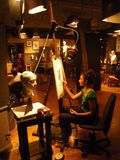25 Oct Telluride Inside … and Out in New York: lunch at the historic Coffee House
 Frances Barlow lives her life with an unbuttoned sense of joy, both in New York, where she runs the theatre she founded, Urban Stages, and in Telluride, where she lives part time with husband Ed Barlow. Telluride Inside…and Out always looks forward to spending time with Frances – and with Ed, whenever his feet touch the ground, which is almost never. The most recent invitation was during our recent trip to New York: lunch at The Coffee House at 20 West 44, where members dine at one long table, discussing anything but work. Here's the backstory based on a speech by Ben Hall at the club's Golden Anniversary Dinner in December, 1965.
Frances Barlow lives her life with an unbuttoned sense of joy, both in New York, where she runs the theatre she founded, Urban Stages, and in Telluride, where she lives part time with husband Ed Barlow. Telluride Inside…and Out always looks forward to spending time with Frances – and with Ed, whenever his feet touch the ground, which is almost never. The most recent invitation was during our recent trip to New York: lunch at The Coffee House at 20 West 44, where members dine at one long table, discussing anything but work. Here's the backstory based on a speech by Ben Hall at the club's Golden Anniversary Dinner in December, 1965.
Unrecorded in the annals of the Knickerbocker Club is an event which might be called the Great Coffee House Rebellion. One day in January, 1914, two members of the Knickerbocker—Frank Crowninshield and Rawlins L. Cottenet—met for lunch at a midtown hotel and agreed that they were fed up to the tops of their Arrow collars with the Knickerbocker and its brass-buttoned flunkies, silver duck-presses, and gold-plated table conversation. According to Crowninshield’s recollections, they decided that “it would be agreeable and desirable to found a small dining club composed of such members of the Knickerbocker Club as had no sympathy with business or wealth or with such things that business and wealth produced or implied.”
The Foes of Finance continued to meet more or less regularly during 1914 at such spots as the Café Lafayette, Oscar and Billy’s Chop House on Thirty-Sixth Street, Luchow’s, and The Knickerbocker Hotel. Their number was brought up to ten with the addition of Frederic Kernochan and Thomas Slidell. Some time in the fall of 1915 it became apparent that no more allies were to be recruited from the Knickerbocker Club, and if the group were to increase it would have to start finding members elsewhere. Accordingly, a luncheon was held to discuss plans for a new club with permanent rooms of its own. Crowninshield’s vision, which he first articulated in a memorandum he had written in 1907, seems almost clairvoyant.
“On a side street in the theatre district. Two hundred members. Up one flight. Club to be called the Beefsteak, or some similar name. One long dining table. Dues, $30 a year. Club to consist of one big room, one music room, and grill room. These rooms to open at one in the afternoon and close at midnight. No brokers or bankers and perhaps no drama critics. No card playing. The club to be for sculptors, artists, foreigners, illustrators, authors, editors, professors, sportsmen, lawyers, actors, singers, playwrights, musicians, inventors, composers, statesmen, judges, etc. Members to pay cash for everything. The club would be a revolt against the marble palace idea and would be very simple and cheap.”
Thus was born The Coffee House, which for the next sixty-seven years was quartered in the Hotel Seymour, at 54 West 45th Street. (The name “Coffee House” was decided on in the hope that the Club might take its character from the coffee houses which first appeared in London during the reign of Charles II, and had grown to such popularity by Queen Anne’s time that they were patronized by all the wits and talent of the town.) In 1982, demolition of the hotel began and the Club was required to move. Fortunately, another brownstone was found, just a few doors to the west at No. 70 on the same street. After extensive renovations of those premises, The Coffee House reopened in August 1983, with its accustomed furnishings refurbished and redeployed.
 Joining us at lunch on Friday, October 23 was another Tellurider, documentary filmmaker Josh Aronson, who has recently completed a series of shorts to celebrate and promote the 400th anniversary of Europeans on the Hudson River. Film subjects range from a portrait of a landscape painter to the birth of environmentalism; from the story of a Coast Guard icebreaker maintaining the Hudson channel to the perspective of a present-day lighthouse keeper. WNET (Thirteen) is the presenting New York station for PBS's nine statewide affiliates.
Joining us at lunch on Friday, October 23 was another Tellurider, documentary filmmaker Josh Aronson, who has recently completed a series of shorts to celebrate and promote the 400th anniversary of Europeans on the Hudson River. Film subjects range from a portrait of a landscape painter to the birth of environmentalism; from the story of a Coast Guard icebreaker maintaining the Hudson channel to the perspective of a present-day lighthouse keeper. WNET (Thirteen) is the presenting New York station for PBS's nine statewide affiliates.
 After a tasty lunch of comfort food – Hungarian goulash over penne with zucchini – Frances showed us around the building, which also houses The Grand Central Academy of Art, dedicated to creating a positive environment for classical instruction in drawing and painting. A peak inside the ateliers was a glimpse at the art scene in pre-Impressionist France, in the days the Academy reigned supreme.
After a tasty lunch of comfort food – Hungarian goulash over penne with zucchini – Frances showed us around the building, which also houses The Grand Central Academy of Art, dedicated to creating a positive environment for classical instruction in drawing and painting. A peak inside the ateliers was a glimpse at the art scene in pre-Impressionist France, in the days the Academy reigned supreme.


Sorry, the comment form is closed at this time.